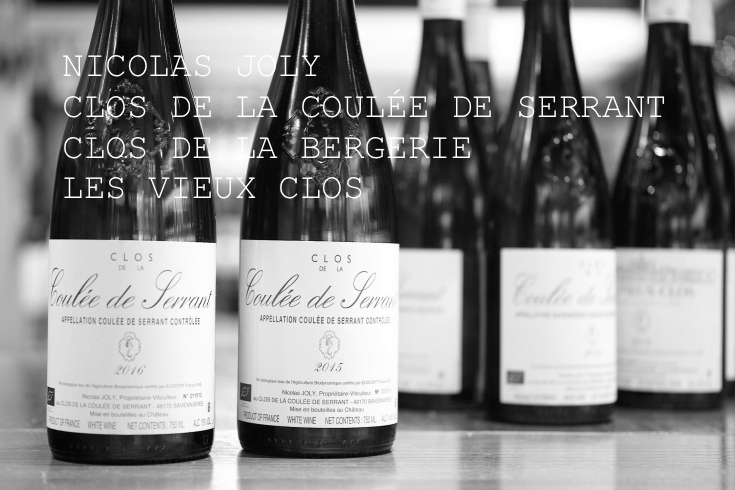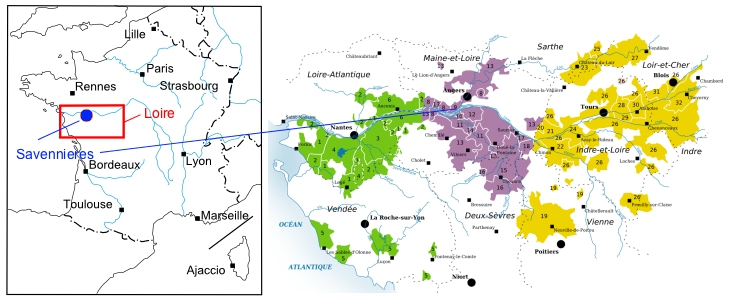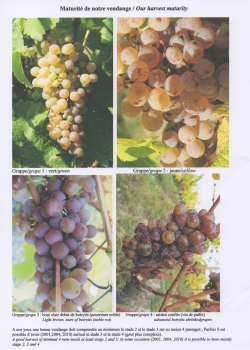 |
 |
 |
 |
Les Vieux Clos
Les Vieux Clos inherits same style of Coulee de Serrant as well as Clos de la Bergerie. Contains Botrytis too. However Vieux Clos is not merely an entry level of Nicolas Joly's wine. Every three cuvees have different characters and size, yet same concentration. Les Vieux Clos has slightly larger-meshed texture than Coulee and its easier to match wide range of cuisines.
Les Vieux Clos carries also appellation Savennières. The vines of an Middle Age of a score of years result from selections massales, and not clonales, to increase aromatic complexity. The grounds are primarily made schists but also sometimes of quartz and more rarely of sand. The outputs are of 30/35 hectolitres per hectare (50 authorized). Wine making out of wood or tank. Production: approximately 15,000 bottles/year.
The quality of a wine is done especially before the harvest : the storeroom should be has our eyes only one maternity and never a factory. The wine making remains very simple; a certain number of acts like the relevurage, aromatic or not, osmosis etc… are banished. The wines are stored especially in old underground or the bases of the castle.

The Domaine
Coulée de Serrant is the finest biodynamic vineyards in the world. It has fascinated many talented great producers, such as Lalou Bize-Leroy and Anne-Claude Leflaive. Coulée de Serrant is a "Monopole AOC" that is able to find only few cases, for example Romanée-Conti and Chateau Grillet. This unique vineyard produces unique wine which is made from 100% Chenin Blanc with botrytis.
Nicolas Joly started Biodynamic farming in 1980. In 1985 or 1986(according to his memory), Lalou Bize-Leroy visited Coulée de Serrant and she understood everything in a moment. Then, she decided to implement biodynamie to her vineyards called "Domaine Leroy". After a while(late 80's), Anne-Claude Leflaive visited Coulée de Serrant and she was deeply inspired - maybe you know the rest of the story. All of these today's finest and natural wines would not have existed without Nicolas Joly's pursuit of truth and its great achievement. After over 40 years management of biodynamie, this vineyard is well-conditioned to express its terroir perfectly. Now this "Monopole AOC" is able to show its maximum potential.
If you stand in this vineyard, you can feel large and deep vibrations. You may understand everything in a moment like Lalou Bize-Leroy. However, it is not necessary to go there because all the elements are perfectly transferred to three wines - Coulée de Serrant, Clos de la Bergerie and Les Vieux Clos - and delivered to your table. Drinking is much more important.


Maturity of grape harvest
It is important to show the customers the impact of grape maturity on the taste of the wine. We harvest late on purpose to gain complexity, linked with a beginning of over maturity. What we call a sort of oxidation on the the grape is different from oxidation linked to a bad cellar management.
On the pictures herewith, with 4 harvest on each parcels (link to a real massal selection and no clones on the estate) we never harvest pict 1, but pic 2 and 3 and sometimes a bit of pic 4. This doesn't affect the ageing capacity of our wines. (Nicolas Joly June 2013) |  |
Natural wine - the wine like fresh fruits
Indeed, the taste of Nicolas Joly wines are always different. Many people are thinking that it's a bottle variation, or wines are unstable.
However, please imagine fresh fruits and canned fruits. Nicolas Joly's wine(and other good natural wines) are much closer to fresh fruits. As fresh fruits is changing every moment and affected by environment, Nicolas Joly's wine is alive in the bottle and perform differently every season, every day and every time zone, rather than bottle variation. On the other hand, most wines which are distributed widely are produced as preserved food such as canned pineapple. Its taste is the same every day(stable and homogenised) and gets older slowly.
Do not confuse oxidation with maturity
Chenin gets its complexity only when it is fully ripe – deep yellow. And only healthy, sustainable farming can guarantee this without grey rot. For this reason, all our grapes are picked in four or five passes as each parcel begins to raisin and form botrytis - thereby allowing the mineral flavours of Chenin to achieve their fullest intensity.
Once uncorked, wines made in this way continue to improve – and are in no way oxidised. To be sure that the colour is not oxidation you can make the test yourself by tasting a glass over several days without putting the bottle in the fridge just recork. You will see the wine develops for several days and sometimes over more than a week.
If the wine becomes oxidised it would be undrinkable.Our wines go well with white meat in sauce, fish with beurre blanc or even simply with a good cheese like goat cheese or Cantal. Uncork few hours in advance or carafe the wine. Serve at 14°C / 57°F. (by Nicolas Joly)
Grapes & Grains: Nicolas Joly, Man of the Earth
The casting Clutching a wine of exceptional outcome of the biodynamic Loire, long version
Talking about Biodynamics - Part I
Talking about Biodynamics - Part II
|
|
 |
 |
 |
 |

|